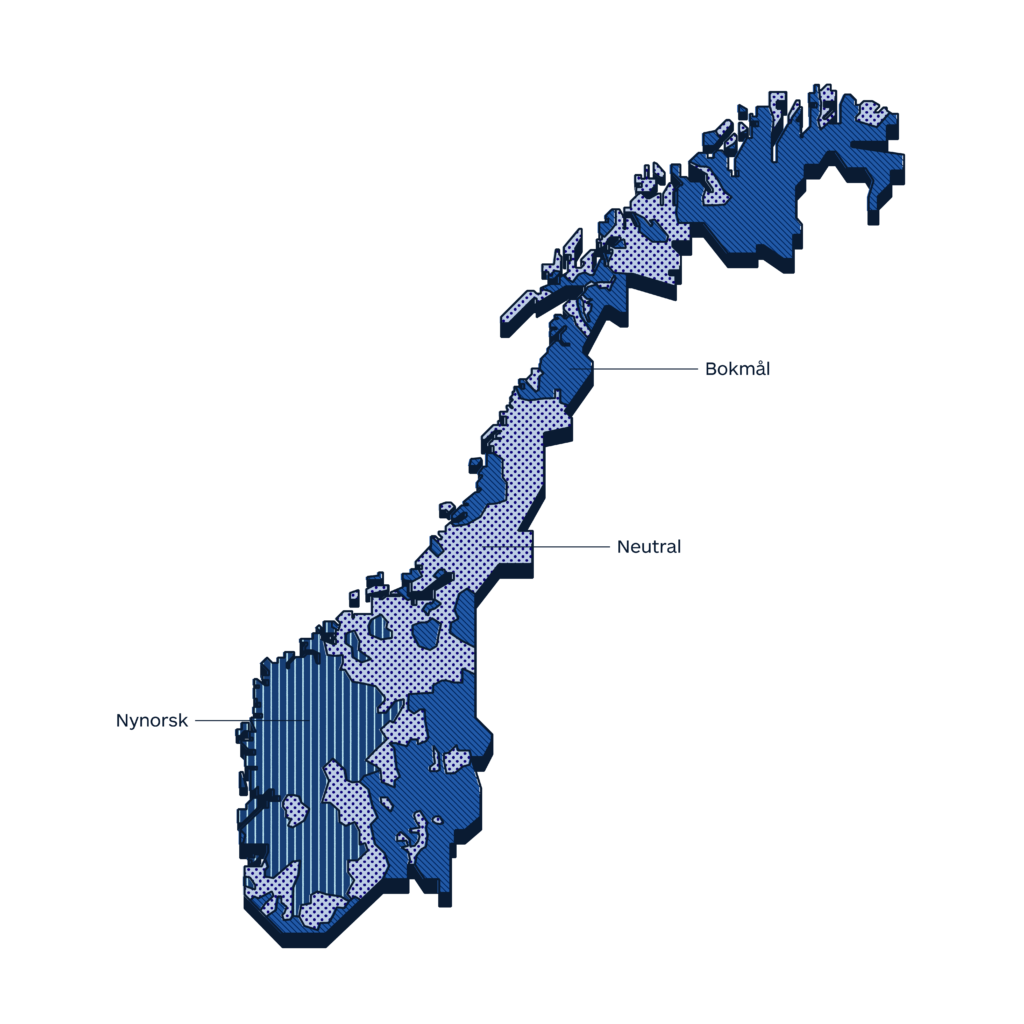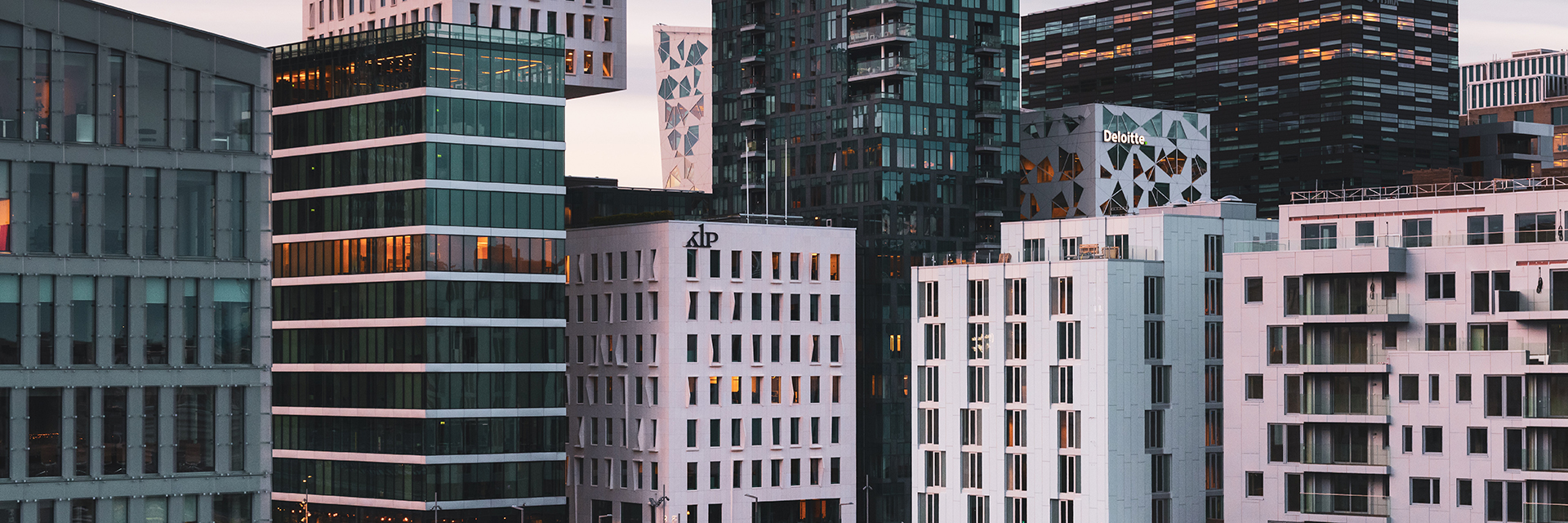Europe
What we know from our community
Norway, the wealthy oil and gas producing country to the very north of Europe, is small in population but relatively large in geographical extension, stretching from the northern tip of Denmark all the way to the Barents sea. To the north-east, Norway borders Russia and the polar island Svalbard is an integral part of Norwegian territory.
Norways geographical size and particular topography, the country is dominated by mountains and valleys, often divided by lakes or fjords. Outside of the main cities, Oslo, Bergen and Trondheim, people live in relatively remote and small rural communities. This feature also makes for a great linguistic diversity; in spite of having a population of only about 5 million people, Norway has two official languages and one protected language. The dialectical variation is significant, people will speak in very different ways in different parts of the country. Yet while this variation is cherished in spoken Norwegian, written Norwegian is standardised.
Most Norwegians will also be comfortable with Swedish and Danish languages.
Introduction
Language
Official language
Norwegian Bokmål, Norwegian Nynorsk, Saami (with certain geographical limitations)
T-index
0.36%
T-Index ranks countries according to their potential for online sales.
Most studied languages
German, Spanish, French Russian, Latin, Japanese, Italian, and Chinese
English
Very high proficiency (EF)– 5 of 112 countries/regions in the world- 4/35 position in Europe.
Demography
Capital: Oslo
Currency: Norwegian krone
Population: 5.41 m
Population density: 15/km2
Economy
GDP: 482.44 billion USD (2020)
GDP per capita: 89,202.8 USD (2020)
Exports: $86.2 billion (2020)
Statistics
Internet users: 99% penetration, 5.43 million
Unemployment rate: 4.4% (2021)
Urbanisation: 82.25% (2018)
Literacy: 99% (2018)
Conventions
Numbering system
Arabic numerals with comma as decimal separator.
Date format: yyyy-mm-dd / dd-mm-yyyy
Time: 24h time system
Country code: 0047
Language data sources: Worldatlas/Britannica//EF/Wikipedia; Demography data sources: IMF/Worldometers; Conventions data source: Wikipedia; Economy data sources: WTO/OEC/CIA/Esomar/Datareportal; Statistics data sources: Datareportal/WorldBank/UN/UNESCO/CEIC/IMF/Culturalatlas/Commisceoglobal
Facts and data
Economy
Imports
$83.9 billion (2020). Cars ($5.29B), Passenger and Cargo Ships ($2.52B), Refined Petroleum ($1.82B), Broadcasting Equipment ($1.76B), and Computers ($1.44B), importing mostly from Sweden ($14.2B), Germany ($9.71B), China ($7.79B), Denmark ($5.72B), and United Kingdom ($5.18B).
Financial inclusion factors (over 15 years of age)
• 100% have an account with a financial institution
• 71% have a credit card
• 89% make online purchases
Ease of doing business
It is very easy to conduct business (rated 82.6 out of 100) ranked 6th out of 34 OECD High Income countries ranked 9th out of 190 countries worldwide (2020, World Bank)
Global Innovation Index
Ranked 12th out of 19 European countries, 20th out of 132 worldwide.
The Global Innovation Index captures the innovation
ecosystem performance of 132 economies and tracks the most recent global innovation trends.
Exports
Exports $86.2 billion (2020). Crude Petroleum ($22.6B), Petroleum Gas ($14.4B), Non-fillet Fresh Fish ($6.49B), Refined Petroleum ($3.68B), and Raw Aluminium ($2.58B), exporting mostly to United Kingdom ($14B), Germany ($9.77B), Sweden ($9.1B), Netherlands ($8.09B), and China ($6.8B).
Main local online stores
Zalando, eBay and CDON.com. Other top retail sites include Komplett.no, XXL, Amazon, Nelly, Bokkilden/Bokklubben, Ellos and H&M
Economic freedom
‘Mostly free’ (rated 76.9out of 100) ranked 10th out of 43 European countries ranked 14th out of 186 countries worldwide (2022, Heritage Foundation and Wall Street Journal)
Economy data sources: WTO/OEC/CIA/Esomar/Datareportal
Service import (2011)
Source: OEC
Service export (2011)
Source: OEC
Most complex products by PCI
Product Complexity Index measures the knowledge intensity of a product by considering the knowledge intensity of its exporters
Source: OEC
Export Opportunities by Relatedness
Relatedness measures the distance between a country's current exports and each product, the barchart show only products that Italy is not specialized in
Source: OEC
Most specialised products by RCA Index
Specialisation is measured using Revealed Comparative Advantage, an index that takes the ratio between Italy observed and expected exports in each product
Source: OEC
Most common payment methods in Norway in 2019
Source: OEC

T-index
Reach most of the online purchasing power
T-Index ranks countries according to their potential for online sales. It estimates the market share of each country in relation to global e-commerce.
Try it nowMedia
Media language
Norwegian
Information channels
Public broadcaster NRK is the media organisation with the highest reach and trust rating among Norwegians. Its flagship TV and radio channels are market leaders. From 2020, it will be funded from the state budget through a dedicated NRK tax, rather than from a licence fee payable by the owners of TV receivers. The commercial sector is dominated by Oslo-based international media group Schibsted, the publisher of leading national dailies Aftenposten and VG, regional papers and online platforms and by the TV2 Group owned by Copenhagen-based Egmont Fonden, the operator of the largest commercial TV channel. Norwegians are among the world’s most avid newspaper readers. In recent years there has been a significant decline in the readerships of print editions and a rise in the number of subscriptions to online newspapers. Norway’s media are viewed as among the freest in the world. The country was ranked first out of 180 countries in the Reporters Without Borders (RSF) World Press Freedom Index 2019, staying in the top spot for the third year in a row. According to Statistics Norway, 98% of Norwegians aged 16–79 had access to the internet in 2018, making Norway one of the world’s most connected countries. Facebook has by far the biggest share of social media traffic.
The press
VG – large-circulation daily
Aftenposten – daily
Dagbladet – mass-circulation daily
Morgenbladet – weekly
Television
NRK – public, operates NRK-1, NRK-2, NRK-3 and NRK Super
TV2 – commercial; NRK’s main competitor
TV3 – commercial
TV Norge – commercial
Radio
NRK – public, operates national and local services
P4 – national, commercial
Radio Norge – national, commercial, music
Radio 1 – commercial, music
Media data source: BBC
The Data Factbook is a work in progress project. Our community is helping us to fill it up always with new and updated data. Your contribution is precious. If you want to help us, please write your advices at imminent@translated.com
Internet Data
Internet users
99% penetration, 5.43 million
Share of web traffic by device
35.13% mobile phones, 63.05% computers (laptops and desktops), 1.80% tablet devices, others 0.02%
Median speed of mobile Internet connection
116.66 Mbps
Median speed of fixed Internet connection
103.19 Mbps
Mobile connection as a percentage of total population: 108.3%
Percentage of mobile connections that are broadband (3G-5G): 97.8%
Most popular web search engines
Google (94.52%), Bing (3.47%),Yahoo (1.18%), Duckduckgo (0.53%), Kvasir (0.07%)
Most used social media
Facebook (73.44%), Twitter (7.22%), Pinterest (6.06%), Instagram (6.19%), YouTube (5.53%), Reddit (0.73%) Tumblr (0.28%)
Internet data sources: Datareportal/Statcounter
Social statistics
Life expectancy
83 yrs (2020)
Gender
Men and women are relatively equal compared to many other countries and the number of women in management positions is increasing also, reaching 37 percent in 2019. There are more women in management positions. Views on sexuality, sexual orientation are generally very liberal, with some geographical differences; views and attitudes tend to be more liberal in and around Oslo than in other, smaller communities around the country.
Glass Ceiling Index
76.9th out 100, ranked 4 out of 29 countries.
The glass-ceiling index measures the environment for working women combining data on higher education, labor-force participation, pay, child-care costs, maternity and paternity rights, business-school applications, and representation in senior jobs.
Religion
Most Norwegians are members of the Church of Norway (Lutheran) by birth but most are not pious or practicing Lutherans.
Graduates (tertiary education):
Norway has an above-average share of the population aged 25–64 with tertiary education (44%, compared to the OECD average of 39%). This larger share is primarily driven by an above-average proportion of adults with a short-cycle tertiary qualification. The proportion of 25–64 year-olds with bachelor’s, master’s and doctoral qualifications is 32%, approximately the same as the OECD average (2019)
Cultural Curiosities
Norway’s high score in the glass ceiling index reflects a very egalitarian society in which the workforce is divided almost equally between women and men. Norway is also a very child-centered society, with a strong welfare system to protect them in their growth.
Generally, Norwegians are very respectful of personal spaces and punctual, they value self-sufficiency and independence in the workspace.
Social statistics sources: WorldBank/UN/UNESCO/CEIC/IMF
The Data Factbook is a work in progress project. Our community is helping us to fill it up always with new and updated data. Your contribution is precious. If you want to help us, please write your advices at imminent@translated.com
Languages research
Languages in Norway

Legend
-
Bokmål
-
Nynorsk
-
Neutral
When written, on the other hand, Norwegian is divided into two main standardised languages, Bokmål and Nynorsk. Bokmål is derived mainly from dialects spoken in the western and north-western parts of the country. Each county (kommune) choose which of these two languages to use at schools and official communication.
In addition, saami, the language spoken by the indigenous saami people, is a protected language in Norway. Saami is used as an official language in certain Saami-dominated areas, alongside Norwegian, and Norwegians have the right to receive official communication in Saami language.
Source: OEC
Photo credit: Jacek Dylag, Unsplash
